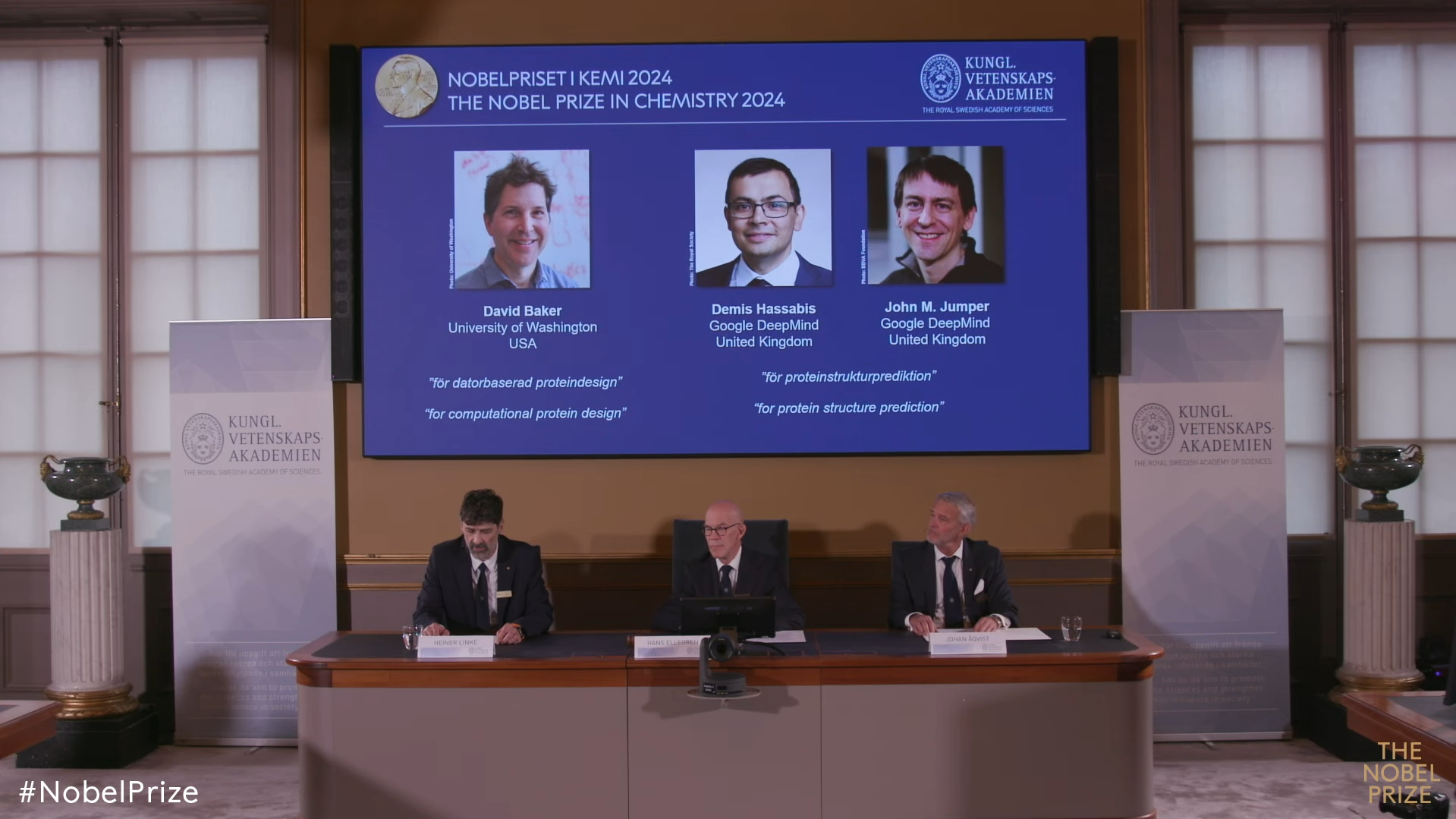For a long time, chemists have aspired to comprehend and become experts in proteins, the molecular building blocks of life. You can now achieve this desire. Artificial intelligence has been effectively used by Demis Hassabis and John M. Jumper to predict the structure of nearly all known proteins. David Baker has discovered a way to synthesise whole new proteins by mastering the basic components of life. Their discoveries have immense promise.
How is life’s vibrant chemistry possible? The existence of proteins, which are essentially excellent chemical instruments, provides an answer to this question. Typically, they are composed of 20 amino acids, which may be mixed and matched in many combinations. In our cells, the amino acids are joined to create lengthy strings using the instructions included in DNA as a blueprint.
Subsequently, proteins exhibit their magical ability as a sequence of amino acids coils and coils, forming a distinct and occasionally unmistakable three-dimensional configuration (Figure 1). The function of proteins is derived from this structure. Some develop into chemical components that can be used to make feathers, horns, or muscles, while others can become hormones or antibodies. Enzymes, which power life’s chemical processes, are formed by several of them.
The promise embodied by these 20 amino acids, the building blocks of life, cannot be overstated. Reaching a whole new level of comprehension and mastery is the goal of the 2024 Chemistry Nobel Prize. Demis Hassabis and John Jumper share half of the award because they used artificial intelligence to tackle a challenge that has plagued scientists for more than 50 years: predicting a protein’s three-dimensional structure from its amino acid sequence. Because of this, they are now able to predict the structures of about 200 million known proteins. David Baker gets the other half of the reward.
Two distinct discoveries are recognised for the 2024 Chemistry Nobel Prize, yet as you shall see, they are closely related. We must go all the way back to the early days of modern biochemistry in order to comprehend the struggles that this year’s laureates have faced.
Although scientists have known for the eighteenth century that proteins are essential to life’s functions, it wasn’t until the 1950s that the precision of chemical instruments allowed scientists to begin delving further into the subject of proteins. When John Kendrew and Max Perutz of Cambridge University successfully presented the first three-dimensional models of proteins near the end of the decade using a technique known as X-ray crystallography, it was a revolutionary finding. They were given the 1962 Chemistry Nobel Prize in honour of their discovery.
Then, after a lot of work and X-ray crystallography, scientists were able to effectively create pictures of almost 200,000 distinct proteins, which served as the basis for the 2024 Nobel Prize in Chemistry.
Another early finding was made by American scientist Christian Anfinsen. He was able to get an already-existing protein to unfold and then fold back up again using a variety of chemical techniques. The protein consistently took on the same structure, which was an intriguing finding. He came to the conclusion in 1961 that the amino acid sequence of a protein is the only factor influencing its three-dimensional structure. As a result, he was given the Chemistry Nobel Prize in 1972.
Cyrus Levinthal, another American, identified a contradiction in Anfinsen’s reasoning in 1969. According to his calculations, a protein may potentially adopt at least 1047 distinct three-dimensional shapes, even if it only has 100 amino acids. Finding the right protein structure would take longer than the universe’s age if the chain of amino acids folded at random. It just takes a few milliseconds in a cell. So how does the string of amino acids actually fold?
Levinthal’s dilemma and Anfinsen’s finding suggested that folding is a predefined process. Importantly, the amino acid sequence has to contain all the information on how the protein folds.
The aforementioned realisations brought about another important realisation: scientists ought to be able to anticipate a protein’s three-dimensional structure if they are aware of the amino acid sequence of the protein. This was a really intriguing concept. If they were successful, they could save a tonne of time and avoid the need for tedious X-ray crystallography. In addition, they would be able to produce structures for any protein for which X-ray crystallography was not suitable.
These rational deductions set the stage for the prediction issue, which has grown to be the main biochemistry task. Researchers launched the Critical Assessment of Protein Structure Prediction (CASP) initiative in 1994 with the goal of promoting faster advancements in the area. The project eventually evolved into a competition. Sequences of amino acids from proteins whose structures had just been established were made available to researchers every other year. The participants were not, however, made aware of the structures. Predicting the protein structures from the known amino acid sequences was the difficult part.
Although a lot of scholars were drawn to CASP, it was quite challenging to solve the prediction problem. There was very little improvement in the correlation between the researchers’ predictions from the competition and the real constructions. It wasn’t until 2018 that a chess master, neuroscientist, and pioneer of artificial intelligence joined the area that there was a breakthrough.
Let’s quickly review Demis Hassabis’ history. He began playing chess at the age of four and attained master status at the age of thirteen. He began working as a programmer and a successful game developer in his teens. He started studying neuroscience after experimenting with artificial intelligence, where he made a number of ground-breaking breakthroughs. He improved neural networks for artificial intelligence by using what he had learnt about the brain. He was a co-founder of DeepMind in 2010; the business created sophisticated AI models for well-known board games. After the business was purchased by Google in 2014, DeepMind gained international recognition two years later when it defeated the world champion player at the time, widely regarded as the pinnacle of artificial intelligence.
But Hassabis saw Go as a tool for improving AI models, not the end in itself. Following this triumph, he and his team felt prepared to take on more pressing issues for mankind, thus in 2018 he signed up for the twelfth CASP competition.
The accuracy of the protein structures that researchers anticipated for CASP in prior years had, at most, reached 40%. Using their artificial intelligence model, AlphaFold, Hassabis’ team achieved around 60%. They prevailed, and the fantastic outcome surprised a lot of people. It was an unanticipated advancement, but the problem still wasn’t solved. In order to be successful, the forecast needed to match the target structure with 90% accuracy.
Despite their best efforts, Hassabis and colleagues were unable to fully complete AlphaFold; the algorithm never truly worked as planned. They had reached a dead end, that much was certain. The crew was worn out, but John Jumper, a relatively recent hire, had clear ideas on how to make the AI model better.
John Jumper began studying physics and mathematics because he was fascinated by the universe. But in 2008, he began working for a business that employed supercomputers to mimic proteins and their movements, and it was then that he discovered how physics expertise might be applied to medical issues.
When Jumper started his doctorate in theoretical physics in 2011, he brought this newfound interest in proteins with him. In an attempt to save computer power, which was scarce at the university, he began creating more straightforward yet clever techniques for modelling protein movements. He soon found himself facing the formidable task of biochemistry. He had just finished his PhD in 2017 when he learnt of allegations that Google DeepMind had begun to secretly predict protein shapes. He applied for a job with them. He was elevated once the team began to stall because of his innovative ideas for improving AlphaFold derived from his knowledge with protein modelling. Hassabis and Jumper co-led the effort that radically altered the AI model.
With the extensive data found in databases including all known protein structures and amino acid sequences, the team trained AlphaFold2 (Figure 2), and just in time for the fourteenth CASP competition, the new AI architecture began to provide impressive results.
After analysing the data in 2020, the organisers of CASP realised that the 50-year-old challenge in biochemistry was finished. It was astonishing that AlphaFold2 performed nearly as well as X-ray crystallography in the majority of situations. When one of the founders of CASP,.
We’ll talk about that again later. We’re going to travel back in time now and highlight a different CASP participant. This is the second half of the Nobel Prize in Chemistry 2024, which is about the process of synthesising novel proteins from the ground up.
David Baker majored in social science and philosophy when he first enrolled at Harvard University. But he did come upon the first edition of the now iconic textbook Molecular Biology of the Cell while taking an evolutionary biology course. He changed his course in life as a result of this. After starting to study cell biology, he gradually developed an interest in protein architectures. He took on the biggest task in biochemistry when he began working as a group leader at the University of Washington in Seattle in 1993. He started investigating protein folding with ingenious experiments. When he started creating computer programs that could predict protein structures at the end of the 1990s, he brought these discoveries with him and created Rosetta.
When Baker used Rosetta for the first time in the CASP competition in 1998, it performed remarkably well compared to other competitors. The notion that David Baker’s team might utilise the program in reverse came about as a result of their success. They should be able to input a desired protein structure and receive ideas for its amino acid sequence, which would allow them to construct wholly new proteins, as opposed to inputting amino acid sequences in Rosetta and extracting protein structures.
De novo design is the discipline in which completely novel proteins are designed. After creating a protein with a completely novel structure, the study team used Rosetta to determine what kind of amino acid sequence would produce the required protein. In order to do this, Rosetta sought for brief protein segments that resembled the target structure by searching a database of all known protein structures. After optimising these pieces and putting out an amino acid sequence, Rosetta did so by using basic understanding of the protein energy landscape.
Baker’s research group inserted the gene corresponding to the intended amino acid sequence in bacteria that generated the required protein in order to test the software’s effectiveness. The protein structure was then ascertained by means of X-ray crystallography.
For the researchers who were working on protein design, Top7 was a revelation. The only thing those who had previously made de novo proteins could do was copy already-existing structures. The distinct structure of Top7 is not found in nature. Furthermore, the protein’s 93 amino acids made it bigger than any other protein made by de novo design.
In 2003, Baker made his discoveries public. This marked the beginning of what can only be called an amazing journey; Figure 4 shows a selection of the many amazing proteins produced in Baker’s lab. Additionally, he made the Rosetta code public, allowing a worldwide research community to continue refining the program and discovering new uses.
The AlphaFold2 code has also been made publicly accessible by Google DeepMind, and anybody may view it. For researchers, the AI model has turned into a treasure trove. By October 2024, over two million users from 190 countries had made use of AlphaFold2. In the past, obtaining a protein structure was sometimes impossible and required years. It can now be completed in a few minutes. The AI model is not perfect, but it estimates the correctness of the structure it has produced, so researchers know how reliable the prediction is. Figure 5 shows a few of the many examples of how AlphaFold2 helps researchers.
The great diversity of life is a reflection of the remarkable adaptability of proteins as chemical instruments. It is astounding that we can now picture the structure of these tiny molecular machines with such ease; this helps us comprehend life’s workings better, enabling us to grasp the development of certain illnesses, the emergence of antibiotic resistance, and the ability of some microorganisms to break down plastic.
As amazing is the capacity to design proteins with whole novel functions. New nanomaterials, tailored medications, quicker vaccination development, smaller sensors, and a more environmentally friendly chemical sector are just a few uses that might result in this for the benefit of humanity as a whole.
Source: The Nobel Prize – Press Release
Last Modified:






